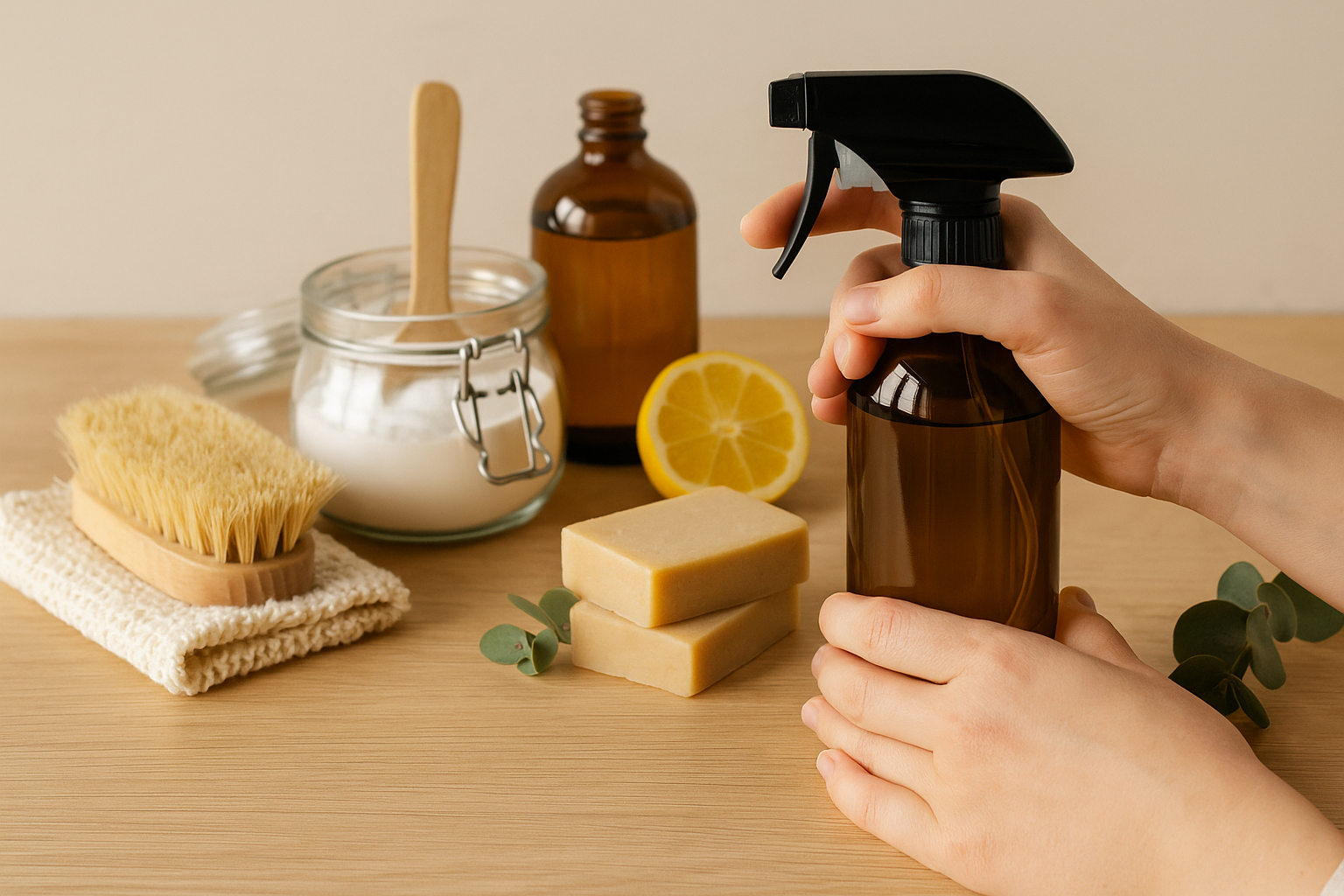Fresh air is one of the most important aspects of a comfortable home. Yet modern life often fills rooms with stale odors from cooking, pets, smoke, or simply lack of ventilation.
Many people rely on commercial sprays or plug-in devices to mask these smells, but synthetic fresheners usually contain chemicals that are irritating and unsustainable.
A healthier solution is to make your own DIY natural air fresheners. Using simple ingredients like herbs, citrus peels, and essential oils, you can create blends that are safe, affordable, and personalized.
Beyond removing odors, they add emotional value and even cultural meaning, connecting modern routines to traditional practices.
This expanded guide will show you why herbs and citrus work so well, the different methods for creating natural air fresheners, detailed recipes for each method, and tips to adapt them to your lifestyle.
Why make natural air fresheners
Healthier environment
Commercial fresheners often contain volatile organic compounds (VOCs). These can trigger allergies, headaches, or worsen asthma. Herbs and citrus release natural compounds that refresh air without synthetic risks.
Personalized scents
By creating your own blends, you control intensity and fragrance style. You might prefer a sharp rosemary-lime spray in the morning, or a soothing marcela-orange mist at night.
Eco-friendly practices
Most DIY recipes reuse citrus peels and dried herbs that might otherwise go to waste. This reduces plastic and packaging, while keeping your home in tune with sustainable living.
Low cost, high value
Homemade sprays cost a fraction of store-bought products. A single orange and a sprig of rosemary can fragrance an entire home for days.
The power of herbs and citrus
Herbs as purifiers
Many herbs naturally contain antibacterial and antifungal compounds. Rosemary sharpens the mind while cleansing air. Sage reduces microbes and brings a smoky depth. Mint refreshes and cools, making it ideal for bathrooms.
Citrus as mood lifters
Orange, lemon, lime, and grapefruit peels release limonene, a compound proven to uplift mood and cut unwanted odors. Their bright aroma also reduces stress and adds cheerful energy to rooms.
Synergy of blends
Herbs and citrus complement one another. Citrus offers light and brightness, while herbs ground the blend and extend fragrance. Together, they create long-lasting, balanced aromas.
Main DIY methods for natural air fresheners
Room sprays
Simple, effective, and versatile. Room sprays are made by combining water, alcohol or witch hazel, and essential oils.
Basic recipe
- 200 ml distilled water
- 1 tsp alcohol or witch hazel
- 8 drops rosemary essential oil
- 6 drops lemon oil
- 4 drops orange oil
Shake before each use. Spray into the air, on curtains, or lightly on sofas.
Variations
- Morning Energy: rosemary, lime, mint.
- Evening Calm: marcela, orange, lavender.
- Holiday Blend: cinnamon, orange, clove.
Simmer pots
A traditional method that fills rooms with fragrance using heat and water.
Basic recipe
- 1 sliced orange
- 1 sprig rosemary
- 1 tbsp cloves
- 1 cinnamon stick
Simmer gently, refilling water as needed.
Seasonal variations
- Spring: lemon, mint, rosemary.
- Summer: lime, boldinho, basil.
- Autumn: orange, guaco, cinnamon.
- Winter: lemon, sage, marcela.
Sachets
Small cloth bags filled with herbs and citrus peels are perfect for closets, drawers, and cars.
Basic recipe
- Cotton bag
- Dried rosemary and lavender
- Dried orange peel
Replace contents every 3–4 weeks.
Creative uses
- Inside shoes to reduce odor.
- In cars for subtle freshness.
- In luggage to avoid musty smell.
Reed diffusers
An elegant option that slowly releases aroma into rooms.
Basic recipe
- 60 ml carrier oil
- 2 tbsp vodka
- 20 drops essential oils (rosemary, lemon, orange)
- 6 reed sticks
Flip reeds weekly for stronger scent.
Cleaning sprays
Fresheners can also double as cleaning aids, leaving surfaces clean and aromatic.
Basic recipe
- 250 ml vinegar water
- 10 drops lemon
- 6 drops rosemary
- 4 drops sage
Spray on counters and dining tables.
Extended recipes for everyday use
Kitchen Deodorizer Spray
- 200 ml water
- 1 tsp alcohol
- 6 drops boldinho
- 4 drops lemon
- 2 drops rosemary
Relaxation Linen Mist
- 200 ml water
- 1 tsp witch hazel
- 8 drops marcela
- 4 drops orange
- 2 drops sage
Bathroom Freshener
- 250 ml water
- 10 drops lemon
- 6 drops peppermint
- 4 drops rosemary
Seasonal Holiday Simmer
- 1 sliced apple
- 1 sliced orange
- 2 cinnamon sticks
- 1 tbsp cloves
- 1 sprig rosemary
How to design daily routines with fragrance
Morning routine
Spray rosemary and lime mist on curtains to start the day with clarity.
Afternoon reset
Simmer citrus peels and boldinho leaves in the kitchen to refresh air after meals.
Evening calm
Spray marcela and orange blend on linens one hour before sleep.
Weekly ritual
Burn a small sage bundle or use sage spray at doorways. This represents closure and renewal.
Seasonal cycle
- Spring: lemon, mint, rosemary.
- Summer: lime, boldinho, basil.
- Autumn: orange, cinnamon, guaco.
- Winter: marcela, sage, lemon.
Cultural significance of herbs and citrus
In Gaúcho tradition, fragrance was part of daily life. Marcela sprays symbolized renewal, rosemary sprigs at doors meant protection, and citrus peels simmered after meals represented cleansing. These scents were not luxuries but cultural practices tied to identity and family care.
Bringing them into modern DIY recipes revives this heritage. Each spray or simmer pot becomes a continuation of ancestral wisdom, adapted to modern life.
Safety tips
- Always dilute essential oils in water and alcohol before spraying.
- Do not apply sprays directly to pets or infants.
- Ventilate rooms when using simmer pots or sage bundles.
- Test sprays on fabric corners before general use.
- Use subtlety. Overpowering scents can overwhelm rather than refresh.
Mistakes to avoid
- Using too many oils at once. Keep blends simple.
- Forgetting to replace sachets. Old herbs lose potency.
- Leaving simmer pots unattended. Safety comes first.
- Expecting instant perfection. Adjust blends to taste.
Long-term benefits of DIY air fresheners
- Health: Fewer synthetic chemicals in the home.
- Cost savings: Homemade blends are cheaper than commercial sprays.
- Cultural preservation: Keeps traditional practices alive.
- Personalization: Every family can design its own signature scent.
- Emotional well-being: Scents support calm, focus, and joy.
Conclusion
DIY natural air fresheners with herbs and citrus are more than odor solutions. They are healthier alternatives, cultural rituals, and creative practices.
By using sprays, simmer pots, sachets, and diffusers, you transform your home into a sanctuary of freshness and meaning.
Every fragrance becomes a story—of health, tradition, and identity. With each spray or simmer, you choose to honor the past and create a safer, fresher future.

Marcela Cardozo is passionate about Southern Brazilian traditions and the cultural stories carried through natural scents. She blends knowledge of native herbs, essential oils, and regional rituals to create practical and inspiring content. Her writing connects ancestral wisdom with modern living, offering readers simple ways to bring authenticity, well-being, and meaning into their everyday lives.
